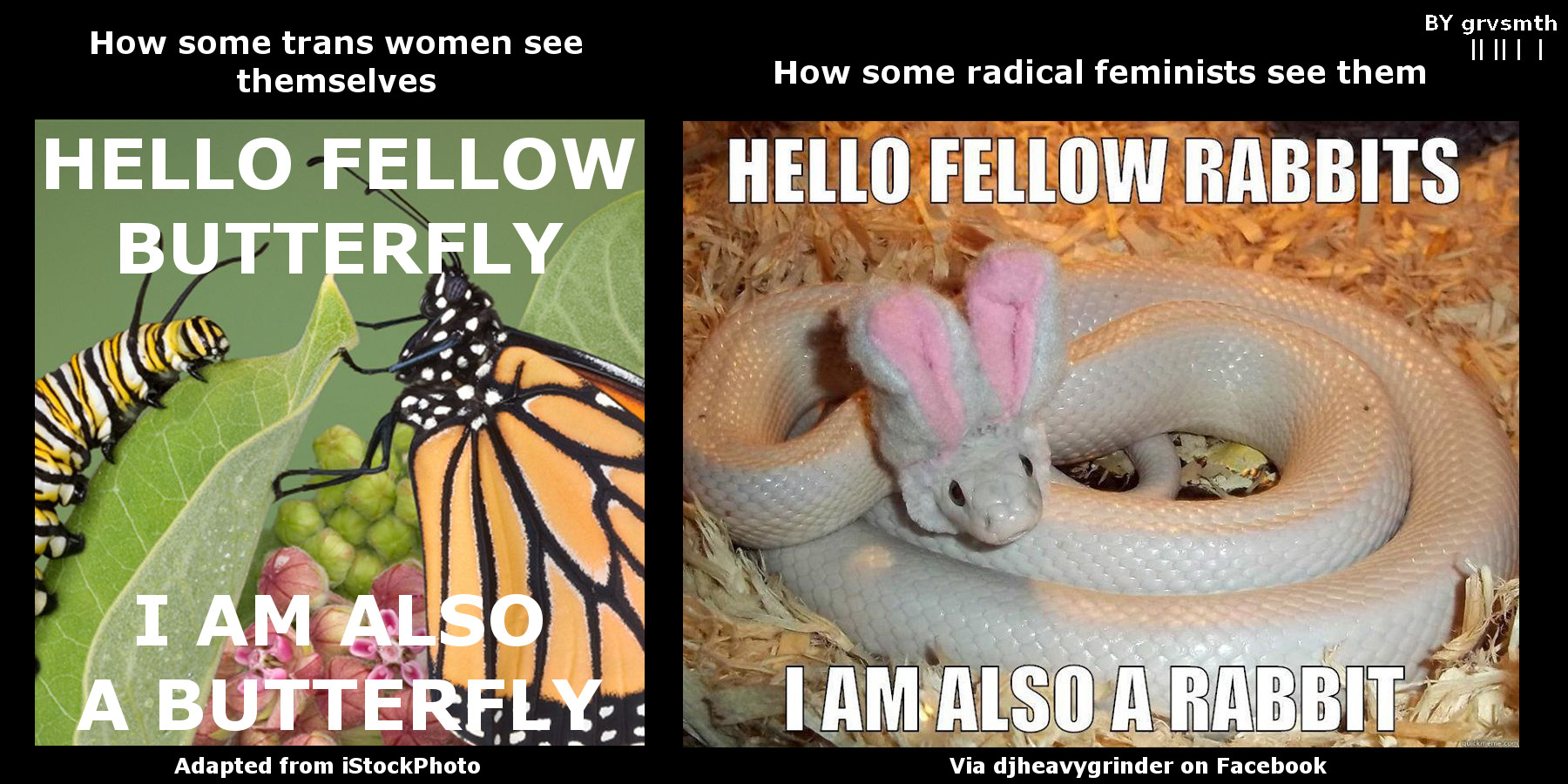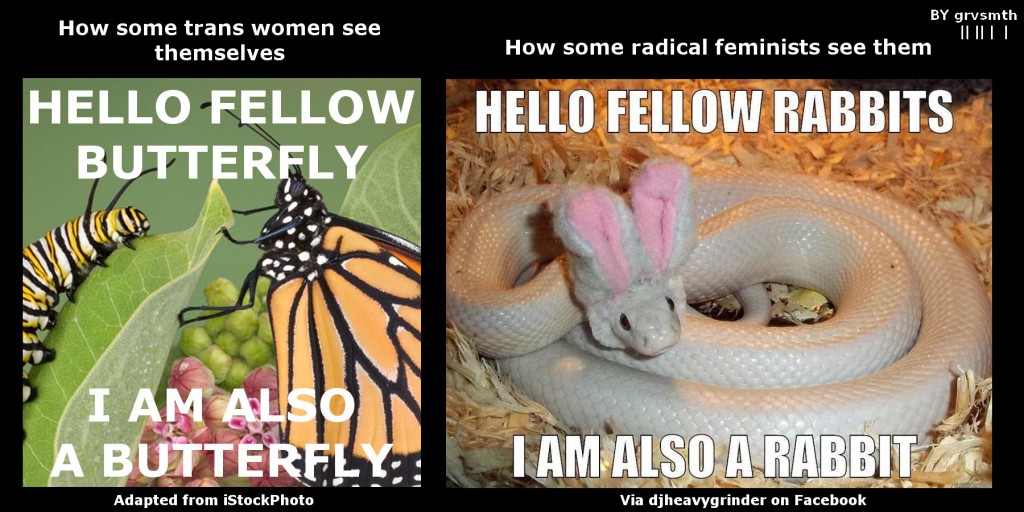This is the first in a series of posts discussing the Slippery Slope, how it works, and how you might be able to avoid sliding down it if you don’t want to. I have already written the entire article in long form, if you want to read the whole thing right away.
There’s an old and tasteless joke:
Q: What’s the difference between a transvestite and a transsexual?
A: Two years.
Nowadays we would say “cross dresser” instead of “transvestite” and “trans woman” instead of “transsexual,” although that is problematic because transvestites and cross dressers are trans women too. Behind this joke lies a common observation: that many people identify at one point in their lives as cross-dressers, butch lesbians or genderqueer, and then later transition to a binary gender different from the one assigned to them at birth.
The “two years” part comes from the fact that this transition typically happens within two years of the time the observer first meets the trans person, or learns about their trans feelings, beliefs or actions. Helen Boyd, in My Husband Betty, called it “the slippery slope,” and described the anxiety that she and other people felt about their non-transitioning trans spouses. They didn’t want their partners to hide in fear, but they also were afraid of losing their partners, or no longer finding them attractive.
Since reading about the “slippery slope,” I’ve watched a good dozen or more people who had insisted they were “just cross dressers” slide down to hormones and full-time name and pronoun changes. (That includes Betty, although she and Helen were able to work out a satisfactory arrangement to continue their marriage.) I’ve read about many more, including celebrities like Lana Wachowski and Caitlyn Jenner.
For the rest of this post I’m going to focus on the “feminine spectrum” of people assigned male at birth who feel a desire to be women, because that’s what I have the most information about. The dynamic is somewhat different for the masculine spectrum, but I believe a close look would find similar factors at work.
A lot of people who have been down the slippery slope say things like, “I always knew deep inside,” or “I had to stop hiding my true self,” but previously insisted just as heavily that they knew deep inside that their true selves were male and that they wanted to live as men for the rest of their lives. Others who now claim certainty used to say that they did not know.
I don’t believe in essential gender, so I don’t buy the claims of essential womanhood made by people at the bottom of the slope or the claims of essential manhood made by those at the top of the slope. But I do believe that people at the bottom of the slope feel more like women than those at the top. This is not because they have tapped into some essence that was already there, but because they have built a feminine identity over the course of that two years or so, often without meaning to or without understanding the consequences.
The consequences are important, because many people at the top of the slope believe that they are essentially different from the transitioners at the bottom. They believe they will never transition, they tell everyone that, and they plan their lives around never transitioning. If they slip down the slope and transition, the consequences for their lives and families are often dramatic.
Other people at the top of the slope do not know whether they are trans, or whether transition is right for them. They want to find out and, often with the encouragement of other trans people, experiment with different forms of feminine presentation. But many of them don’t realize that experimentation changes you. If they slip down the slope, the results of the experiments will tell them to transition. It’s like putting a big thumb on the scale.
As the “two years” joke and Helen’s chapter indicate, a lot of people know that the slippery slope exists. There are three common responses, and one is to reject everything trans and repress all transgender desire. This sometimes “succeeds” in avoiding transition, but repression always makes the person miserable and resentful. In fact, repression can backfire, leading to resentment, rebellion and increased dysphoria.
Another common response is to accept the slippery slope as inevitable, as Natalie Reed did when she told me that gender dysphoria “WILL keep coming back. And it WILL get harder.” If it truly is inevitable, it is important to be honest with our loved ones and begin planning the transition as soon as possible.
When I heard about the slippery slope I wasn’t ready to accept transition as inevitable. I decided to see what I could do to avoid it. I’ve done more than that, though: I’ve kept my eyes and ears open. I’ve paid attention to my own experiences and learned from my mistakes. And like a good video game player, I’ve watched others and learned from their successes and failures.
On the basis of all these observations, I think I understand how the slippery slope works, and I have come up with a set of strategies that I use to keep myself from sliding down. I have been successful: I have avoided both repression and transition, and my peak dysphoria is not much higher than it was when I came out twenty years ago.
These strategies are highly experimental. I don’t know anyone else who has tried them, so I can’t promise they will work for anyone else. But I hope some people will find them useful. If you try them, please let me know your successes and failures.
I want to stress one thing: this is not a prescription for every trans woman. I have no desire to second-guess anyone’s decision to transition, or to discourage anyone from giving transition full consideration. On the contrary, I think all trans people should give transition full and careful consideration. I offer my observations in the hope that other people may find them useful in making their decisions.
These strategies are not easy. But then, repression is not easy, and transition is not easy. Ultimately, we should decide which of the three possibilities to follow based on which one fits best with our vision of our own future. And until we decide, we should experiment and investigate in ways that don’t predetermine our decision.
This concludes the first installment of the Slippery Slope. You can read the next installment, or read on in the full article.






